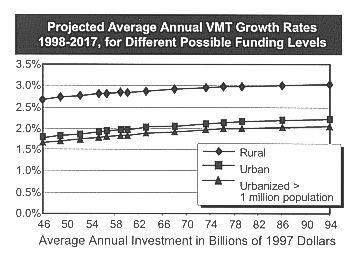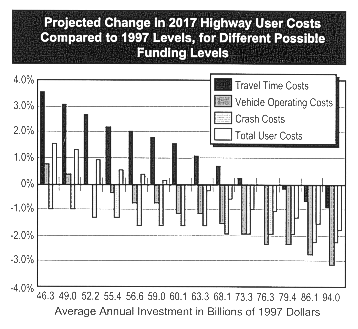U.S. Department of Transportation
Federal Highway Administration
1200 New Jersey Avenue, SE
Washington, DC 20590
202-366-4000
| |
| Conditions and Performance Report Executive Summary |
| Executive Summary Chapter Listing Conditions and Performance Home Page
|
|
The highway VMT forecasts used to develop the 1995 C&P report and earlier editions were static; one fixed growth projection was used for each highway segment. The VMT forecasts used to develop the investment requirements in this report are dynamic. A single set of forecasts is entered into the Highway Economic Requirements System (HERS) for each sample section, but the model then applies travel demand elasticity procedures which change the VMT projections depending on how the conditions on that section are predicted to change over time. If lanes are added, the model assumes that additional travel will be induced. If a highway becomes more congested, the model assumes some drivers will shift to other routes, switch to transit, or forgo some trips entirely. As a result, HERS predicts that travel will grow at different rates, depending on the overall level of investment.  For example, at current funding levels, HERS predicts VMT in urbanized areas over 1 million in population will grow by an average annual rate between 1.66 and 1.70 percent. (This is consistent with an aggregate projection of 1.68 percent, compiled from a survey of Metropolitan Planning Organizations.) If average annual spending increased from $48.7 billion to $94.0 billion, this rate would increase to 2.06 percent. |
The mix of improvements recommended by the HERS model would have different impacts on each component of total highway user costs. If the recommended mix were to be followed, crash costs would be reduced at all levels of investment, as the model predicts there would be a relatively greater rate of return on improve-ments aimed at reducing crashes than on those aimed at reducing congestion. Maintaining travel time costs at current levels would be significantly more expensive than maintaining overall user costs.  There has been a change in the types of highway capital improvements being made in recent years away from new construction, and towards system preservation. This shift is consistent with recent improvements in pavement and bridge conditions. Recent increases in travel density have not resulted in corresponding increases in delay or congestion. This implies that existing facilities are being used more effectively. This may be due in part to increased investment in traffic operational improvements. |